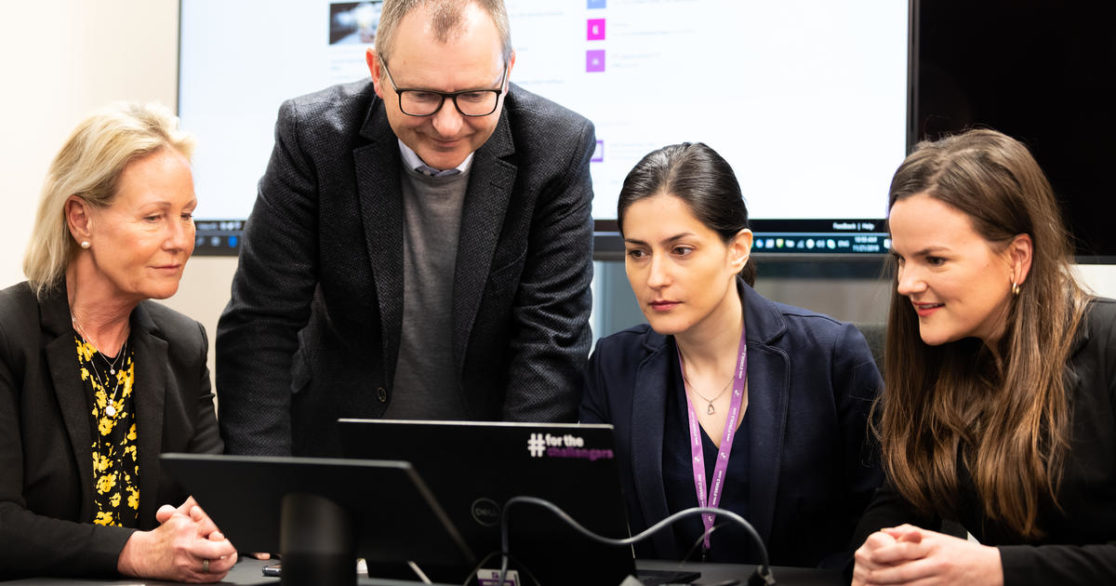Finance and human capital management (HCM) are the foundations of global business operations, and they are being affected by regular and unpredictable changes to business models, customer expectations, market risks, regulation and new technologies.
The obvious tremors, of course, are Brexit in the UK and the global rise of economic and social populism, causing increased protectionism, is unpredictably driving landed cost of parts and components and hammering sales projections in export markets. Protectionism is also causing wild fluctuations in exchange rates. Regardless of where you are in the world, geopolitical instability means HCM and finance must both be agile enough to adjust to constant change.

Prediction 1: Process innovation will force the hand of evolution
Technological change is creating new skill sets to pursue, retain and manage. Disruptive technology like artificial intelligence (AI) and robotic process automation (RPA) are being adopted by and changing HCM and finance disciplines directly. But on a deeper level, technology is changing the way not just individual departments operate, but the company’s overall business model.
AI, RPA and the internet of things (IoT) can create new opportunities and ways of creating value. So, we need a workforce with a fluid understanding of these technologies to creatively apply them to business problems, address markets in a unique way, or form new product or service categories.
One of these emerging business disciplines is servitization, in which goods are augmented by or delivered as services. This strategy has several advantages. Sales become recurring, delivering predictable revenue streams rather than lumpy business that characterizes product-oriented businesses. We will also see increasingly sophisticated approaches to make/buy or outsource/insource decisions to give executives clear options in rapidly changing conditions.
Servitization is building revenue streams through services rather than products alone. Find out what stops companies from embracing servitization in this ebook. #ForTheChallengers https://t.co/RGmnBnP3Yy pic.twitter.com/UR1pza3As7
— IFS (@ifs) December 30, 2019
This clearly goes beyond the previous focus of technology—which had been incremental process improvement. The new transformational nature of technology becomes a core element of the process. For example, an enterprise managing an audit trail through a blockchain removes the need to store information in a database. Instead of an online database, however, the company will need expert personnel who comprehend not only blockchain, but the nature of change it can bring to business.
Technology will enable executives to proactively create new business processes and opportunities. It must also help businesses react to major external trends, including sustainability, which is becoming more important than ever. Audit, trace and report capability is becoming fundamental, whether that data originates in a single system or set of systems.
I predict we’ll hear of at least two new global businesses this year that are disrupting their market through creative application of disruptive technologies.

Prediction 2: New technologies will force companies to prioritize on upskilling and right-skilling
Changing technologies and priorities mean human capital must become more agile. IFS itself has become more focused on learning and development than ever before. This has happened organically to reflect the pace of innovation referenced in the first section above.
The right-skilling process starts with recruitment, whether of internal staff or external outsourcing partners. “Upsourcing” requires a lifecycle approach to staff training and skill set development. But as new technologies come to market, companies will face a steep delta between internal skills and the number of positions that need to be filled.
What we are witnessing now is a move into strategic HCM, as McKinsey says in this report, so if a business wants to introduce RPA and achieve a return on investment, this requires the right-skilling of some of the people on their team. This, in turn, means there needs to be a process in place to attract and recruit from universities and other companies, and retrain some existing staff. Consider that the World Economic Forum predicts that 58 percent of businesses will have adopted immersive technologies by 2022. Where will the supply of experts in augmented, artificial and mixed reality come from? Will they also understand the business problems the technologies must solve?
In 2020 and beyond, businesses must recognize this sea change and become more focused on training and education. In a 21st Century global business environment, there must be a culture of continuous learning that is flexible enough to accommodate the inherent cultures of operations in a variety of countries and geographies. Therefore, I predict that in 2020, we will see increasing interest in lifelong learning, as agile thinkers in middle management move into more senior roles.

Prediction 3: Governance and sustainability will tie innovation and skills together
Innovation and right-skilling are important pieces of the corporate jigsaw puzzle, and they must deliver value in a way that is sustainable and falls within the parameters of solid corporate governance. Internal and market-facing initiatives often drive these efforts and may outstrip governmental requirements. But at a minimum, technology must streamline compliance and documentation with regulations across the various geopolitical divisions a business may cross.
Reaching sustainability goals is not just a matter of optics: customers and other stakeholders demand real action.
The complication is that there is no universal agreement as to what “sustainable” might mean, at least when it comes to regulatory standards. Even carbon emissions and related climate change are not consistently used as a benchmark of compliance. As companies are becoming more global in their own operations or in their supply chains, HCM and finance systems must seamlessly adjust to global regulatory standards and stakeholder expectations.
The desire for change is certainly there from a consumer perspective, but it’s not without its challenges – particularly for industries that have complicated #supplychain. Here's how #technology can make strides in #sustainability. https://t.co/xgM2J1uFtm
— IFS (@ifs) January 8, 2020
Certifying business processes to existing standards is of limited help here, as even the ISO 26000 Social Responsibility Standard offers only high-level guidance on factors to consider in a plan more than a global methodology for compliance. It is vital to be compliant with all current legislation, of course. However, legislation almost always lags behind reality. To take a small-scale example, many computer monitors carry a logo saying they are “energy star compliant” which sounds like a great thing until you consider that this standard has been around since the 1980s and nobody has made any non-compliant monitors since that time. The switched-on user will want a lot more than the legal minimum, and, in this case, companies want to provide complete visibility to where parts are sourced, the conditions in those factories, how responsibly raw materials are mined and the manufacturer’s plan for end-of-life disposal.
I think it is safe to assume that sustainability requirements will continue to extend well beyond what is required by law. ISO 26000 will not become become mandatory in the foreseeable future. Instead, I believe we will see industrial buyers and consumers adopting their own holistic approach to whether a business entity is a decent corporate citizen. They may do this to meet their own customers’ social responsibility programs, or to avoid catastrophes like Volkswagen’s 2015 omissions scandal, financial risk management nightmares like those faced by PG&E or legal exposures like those faced by TC Energy over leakage at the Keystone Pipeline.
The notion of sustainability goes beyond the environment and takes into consideration impact on the workforce and even business classes including small and minority- and female-owned businesses and businesses in specific demographic areas. Internally, social responsibility dictates that we focus on the wellness and mental health of employees and maintain visibility of any ethical exposure.
A broad approach to enterprise software and data are required to manage all these enterprise initiatives from a central vantage point. I predict that enterprise technologies that succeed in 2020 will be those that have a centralized strategy for analysis of enterprise information for complete visibility and control. Much of their transaction, asset, HCM and financial data might be in a central application, but for data in other applications or locations, they will require easy application program interface (API) support for reliable visibility of provenance and conditions under which materials or products are manufactured and sourced.

Market demands innovation
From new technologies making their way to practical application, and resulting new business models, to more societally-conscious consumers and stakeholders, operational executives need greater control over business than ever before. While technology has in the past given us incremental improvements in businesses processes, it will now play a more central role in how we create value for customers or stakeholders. And it must give us the tools to make sure we are evolving the business not just technologically, but in terms of how well it serves our community and the world.
I welcome comments on this or any other topic concerning Finance, HCM, CSR, and Business Strategy. Connect, discuss, and explore using any of the following means:
Twitter: @stevetreagust
IFS website: IFSworld.com
Email: Steve.Treagust@ifsworld.com
Blog: Blog.IFSworld.com/author/steve-treagust
LinkedIn: Linkedin.com/in/stevetreagust
apollinejass
great
Cheryl Beebe
Now that the New Year is underway, it is important to understand the trends for 2020 when it comes to finance. It is a good idea to get ahead of these trends so that you can take advantage of them.